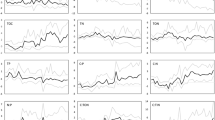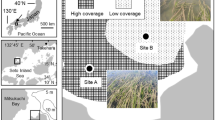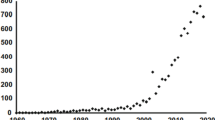Abstract
Phytoplankton growth (μ) and grazing loss (g) rates were measured monthly by the Landry-Hassett dilution method over a 2-year period at both estuarine (Klang) and coastal water (Port Dickson) systems along the Straits of Malacca. Chlorophyll a (Chl a) concentration ranged from 0.20 to 4.47 μg L−1 at Klang except on two occasions when Chl a spiked above 10 μg L−1. In contrast, Chl a concentrations were relatively stable at Port Dickson (0.14 to 2.76 μg L−1). From the rate measurements, μ was higher (t = 2.01, df = 43, p < 0.05) at Klang (0.30 to 2.26 day−1) than at Port Dickson (0.18 to 1.66 day−1), but g was not significantly different (p > 0.80). g ranged from 0.30 to 1.50 and 0.21 to 1.51 day−1 at Klang and Port Dickson, respectively. In this study, grazing loss was coupled to phytoplankton growth, and the ratio of g/μ or grazing pressure which estimates the proportion of primary production grazed was 50 % at Klang and lower than at Port Dickson (68 %; t = 2.213, df = 36, p < 0.05). We found that the higher growth rates in a eutrophic system, i.e., Klang, were not matched by higher grazing loss, and this may have implications for the biogeochemical cycling in coastal waters.







Similar content being viewed by others
References
Alongi, D.M., Chong, V.C., Dixon, P., Sasekumar, A., & Tirendi, F. (2003). The influence of fish cage aquaculture on pelagic carbon flow and water chemistry in tidally dominated mangrove estuaries of Peninsular Malaysia. Marine Environmental Research, 55, 313–333.
Azam, F., Fenchel, T., Field, J.G., Gray, J.S., Meyer-Reil, L.A., & Thingstad, F. (1983). The ecological role of water-column microbes in the sea. Marine Ecology Progress Series, 10, 257–263.
Bong, C.W., & Lee, C.W. (2011). The contribution of heterotrophic nanoflagellate grazing towards bacterial mortality in tropical waters: comparing estuaries and coastal ecosystems. Marine and Freshwater Research, 62, 414–420.
Boyce, D.G., Lewis, M.R., & Worm, B. (2010). Global phytoplankton decline over the past century. Nature, 466, 591–596.
Calbet, A. (2001). Mesozooplankton grazing effect on primary production: a global comparative analysis in marine ecosystems. Limnology and Oceanography, 46, 1824–1830.
Calbet, A., & Landry, M.R. (2004). Phytoplankton growth, microzooplankton grazing, and carbon cycling in marine systems. Limnology and Oceanography, 49(1), 51–57.
Chen, B., Landry, M.R., Huang, B., & Liu, H. (2012). Does warming enhance the effect of microzooplankton grazing on marine phytoplankton in the ocean? Limnology and Oceanography, 57(2), 519–526.
Cloern, J.E., Cole, B.E., Wong, R.L.J., & Alpine, A.E. (1985). Temporal dynamics of estuarine phytoplankton: a case study of San Francisco Bay. Hydrobiologia, 129, 153–176.
Cole, J.J. (1999). Aquatic microbiology for ecosystem scientists: new and recycled paradigms in ecological microbiology. Ecosystems, 2, 215–225.
del Giorgio, P.A., Cole, J.J., & Cimbleris, A. (1997). Respiration rates in bacteria exceed phytoplankton production in unproductive aquatic systems. Nature, 385, 148–151.
Falkowski, P.G., Barber, R.T., & Smetacek, V. (1998). Biogeochemical controls and feedbacks on ocean primary production. Science, 281, 200.
Field, C.B., Behrenfeld, M.J., Randerson, J.T., & Falkowski, P.G. (1998). Primary production of the biosphere: integrating terrestrial and oceanic components. Science, 281, 237–240.
Grasshoff, K., Kremling, K., & Ehrhardt, M. (1999). Methods of seawater analysis (3rd ed.). Weinheim: Wiley-VCH.
Gutiérrez-Rodríguez, A., Latasa, M., Mourre, B., & Laws, E.A. (2009). Coupling between phytoplankton growth and microzooplankton grazing in dilution experiments: potential artifacts. Marine Ecology Progress Series, 383, 1–9.
Hammer, Ø., Harper, D.A.T., & Ryan, P.D. (2001). PAST: paleontological statistics software package for education and data analysis. Palaeontologia Electronica, 4, 1–9.
IPCC (Intergovernmental Panel on Climate Change). (2007). Climate change: the physical science basis. Contribution of Working Group I to the 4th Assessment Report of the Intergovernmental Panel on Climate Change. Cambridge: Cambridge University Press.
Irwin, A.J., & Oliver, M.J. (2009). Are ocean deserts getting larger? Geophysical Research Letters, 36, L18609.
Kirchman, D., Peterson, B., & Juers, D. (1984). Bacterial growth and tidal variation in bacterial abundance in the Great Sippewissett Salt Marsh. Marine Ecology Progress Series, 19, 247–259.
Kuipers, B.R., & Witte, H.J. (1999). Grazing impacts of microzooplankton on different size classes of algae in the North Sea in early spring and mid-summer. Marine Ecology Progress Series, 180, 93–104.
Landry, M.R. (2014). On database biases and hypothesis testing with dilution experiments: response to comment by Latasa. Limnology and Oceanography, 59(3), 1095–1096.
Landry, M.R., & Hassett, R.P. (1982). Estimating the grazing impact of marine micro-zooplankton. Marine Biology, 67, 283–288.
Landry, M.R., Haas, L.W., & Fagerness, V.L. (1984). Dynamics of microbial plankton communities: experiments in Kaneohe Bay, Hawaii. Marine Ecology Progress Series, 16, 127–133.
Lee, C.W., & Bong, C.W. (2008). Bacterial abundance and production and their relation to primary production in tropical coastal waters of Peninsular Malaysia. Marine & Freshwater Research, 59(1), 10–21.
Lee, C.W., & Bong, C.W. (2012). The relative importance of viral lysis and grazing towards bacterial mortality in tropical coastal waters of Peninsular Malaysia. Bulletin of Marine Science, 88(1), 1–14.
Lee, C.W., Bong, C.W., & Hii, Y.S. (2009). Temporal variation of bacterial respiration and growth efficiency in tropical coastal waters. Applied and Environmental Microbiology, 75(24), 7594–7601.
Lee, C.W., Lim, J.H., & Heng, P.L. (2013). Investigating the spatial distribution of phototrophic picoplankton in a tropical estuary. Environmental Monitoring and Assessment, 185, 9697–9704.
Liu, H., Suzuki, K., Nishioka, J., Sohrin, R., & Nakatsuka, T. (2009). Phytoplankton growth and microzooplankton grazing in the Sea of Okhotsk during late summer of 2006. Deep-Sea Research I, 56, 561–570.
Ma, L., Cao, W., Zhang, W., Lin, Y., Zheng, L., Yang, W., & Wang, Y. (2014). An ecological study on zooplankton in the northern Beibu Gulf V: the effects of microzooplankton grazing on phytoplankton in summer. Acta Ecologica Sinica, 34(3), 546–554.
Mann, K.H. (1993). Physical oceanography, food chains, and fish stocks: a review. ICES Journal of Marine Science, 50, 105–119.
Moal, J., Martin-Jezequel, V., Harris, R.P., Samian, J.-F., & Poulet, S.A. (1987). Interspecific and intraspecific variability of the chemical composition of marine phytoplankton. Oceanologica Acta, 10, 339–346.
Modigh, M., & Franzé, G. (2009). Changes in phytoplankton and microzooplankton populations during grazing experiments at a Mediterranean coastal site. Journal of Plankton Research, 31(8), 853–864.
Pagano, M., Champalbert, G., Aka, M., Kouassi, E., Arfi, R., Got, P., Troussellier, M., N’Dour, E.H., Corbin, D., & Bouvy, M. (2006). Herbivorous and microbial grazing pathways of metazooplankton in the Senegal River Estuary (West Africa). Estuarine, Coastal and Shelf Science, 67, 369–381.
Parsons, T.R., Maita, Y., & Lalli, C.M. (1984). A manual of chemical and biological methods for seawater analysis. Oxford: Pergamon Press.
Paterson, H.L., Knott, B., Koslow, A.J., & Waite, A.M. (2008). The grazing impact of microzooplankton off south west Western Australia: as measured by the dilution technique. Journal of Plankton Research, 30, 379–392.
Pomeroy, L.R. (2001). Caught in the food web: complexity made simple? Scientia Marina, 65, 31–40.
Pomeroy, L.R., & Wiebe, W.J. (2001). Temperature and substrates as interactive limiting factors for marine heterotrophic bacteria. Aquatic Microbial Ecology, 23, 187–204.
Schmoker, C., Hernandez-Leon, S., & Calbet, A. (2013). Microzooplankton grazing in the oceans: impacts, data variability, knowledge gaps and future directions. Journal of Plankton Research, 35(4), 691–706.
Stukel, M.R., Landry, M.R., Benitez-Nelson, C.R., & Goericke, R. (2011). Trophic cycling and carbon export relationships in the California current ecosystem. Limnology and Oceanography, 56(5), 1866–1878.
Turner, J.T. (2002). Zooplankton fecal pellets, marine snow and sinking phytoplankton blooms. Aquatic Microbial Ecology, 27, 57–102.
Welch, P.S. (1948). Limnological methods. Philadelphia: Blakiston Company.
York, J.K., Costas, B.A., & McManus, G.B. (2010). Microzooplankton grazing in green water-results from two contrasting estuaries. Estuarine and Coasts, 34, 373–385.
Yoshiyama, K., & Sharp, J.H. (2006). Phytoplankton response to nutrient enrichment in an urbanized estuary: apparent inhibition of primary production by overeutrophication. Limnology and Oceanography, 51(1), 424–434.
Zar, J.H. (1999). Biostatistical analysis (4th ed.). Upper Saddle River: Prentice Hall.
Acknowledgments
We are grateful to the University of Malaya for the grants (UM.C/625/1/HIR/050, RU006D-2014 and PV060/2011B) that supported this work. We also thank the Ministry of Science, Technology and Innovation for the eScience grant (04-01-03-SF0671) and the Ministry of Education for the HiCoE grant (IOES-2014D).
Author information
Authors and Affiliations
Corresponding author
Rights and permissions
About this article
Cite this article
Lim, J.H., Lee, C.W. & Kudo, I. Temporal variation of phytoplankton growth and grazing loss in the west coast of Peninsular Malaysia. Environ Monit Assess 187, 246 (2015). https://doi.org/10.1007/s10661-015-4487-5
Received:
Accepted:
Published:
DOI: https://doi.org/10.1007/s10661-015-4487-5




